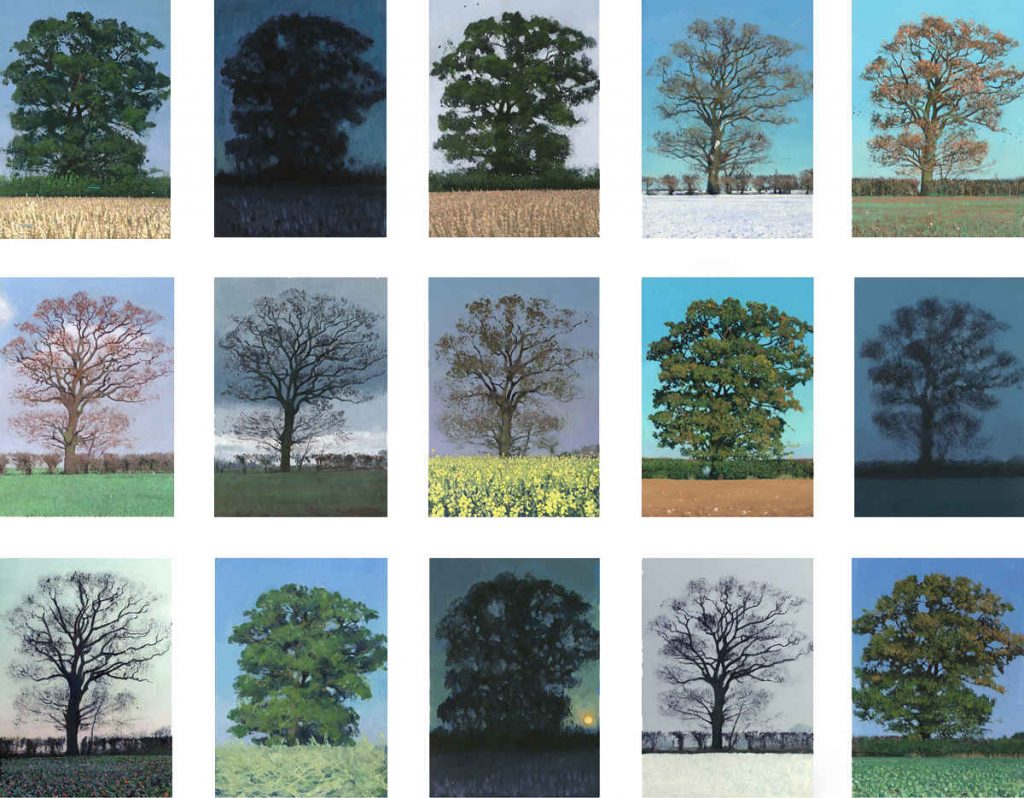Death, rebirth and the act of prayer in Stephen Taylor’s oak tree
I learned of British painter Stephen Taylor from a book by Alain de Botton titled “The Pleasures and the Sorrows of Work.”
Taylor, wrote de Botton, “has spent much of the last two years in a wheat field in East Anglia repeatedly painting the same oak tree under a range of different lights and weathers. He was out in two feet of snow last winter and this summer, at three in the morning, he lay on his back tracing the upper branches of the tree by the light of a solstice moon.”
“Oak: One Tree, Three Years, Fifty Paintings” (2012) is Taylor’s own book, his own words about his work.
Taylor, who was born in 1958, encountered the tree while grieving the deaths of both parents and a girlfriend, all within the same year.
At the Essex boarding school where he was employed as resident artist, he was drawn to stories of death and rebirth. He did some paintings of crucifixions. Gradually he realized something was missing, “a constant from my childhood life — the countryside.
“I certainly had a sense of place, and I had shared it with others. But I had not created a sense of how thousands of smaller worlds exist within a panorama — each with its own character.”
He had already painted and taught for many years. He had done Ph.D. research on the English landscape painter John Constable.
Out walking in the countryside one day, he was “overpowered by a feeling that something in this very ordinary tree was crying out to be set down to paint, and that if he could only do it justice, his life would in indistinct ways be redeemed, and its hardships sublimated.”
He ended up painting his tree in snow and storms, at dawn, high noon, dusk, the middle of the night, and through a lunar eclipse. He painted the tree with, at various times, swallows, wood pigeons, blackbirds and blue tits flitting about.
He painted the tree during every phase of the crop-rotation sequence, from oilseed rape to wheat to barley. He once saw the tree, after watching a film about the English Civil War, as green fire.
He could spend months on a single canvas. He sometimes forgot to eat.
“In bright weather,” he observed, “contrast effects are easily visible. For example, if you look at the faintly yellow highlights of snow then at a dark tree trunk, the trunk momentarily seems blue — a contrast effect. If you look back at the snow and peer into its shadows, a blue-violet light appears. The sky is equally colourful: overhead is ultramarine with a red undertone, the horizon a neon turquoise. Dramatic, stark, and alive, the colours challenge you.”
Taylor made his first oak tree painting on a June afternoon in 2003 and completed the series in August of 2006.
Wrote de Botton of that time: “Taylor is tormented by a sense of responsibility for the appearance of things. He can be kept awake at night by what he sees as an injustice in the colour of wheat or an uneasy fault line between two patches of sky.”
“Absolute attention is prayer,” observed Simone Weil.
Marketing and technology manipulate the contemporary gaze to glance across and bounce off a million glittery surfaces a day. To stay in one place, to look ever more deeply at one thing, to spend three years giving glory to a single oak approaches, to my mind, a religious act.
Taylor now lives and paints in Wales. He finds himself especially drawn to waterfalls. He recently spoke, along with a philosopher and a Christian theologian, at a panel held at St. Albans Cathedral. The subject of his talk: “Why Painting Matters.”
He explained: “The talk explores the slow, hand made contact with the world that good paintings make — as opposed to photos which are, after all, instant, indirect machine images. Each contact is a unique encounter which teaches the endless richness of nature. Cézanne, for example, saw no end to the variation of Mont Sainte-Victoire, or Constable his valley, and so on. The encounter also shows a world independent of us, that cannot be owned.
“Properly felt, all this might be frightening. We are not made for daily infinity, and can be undermined by it. But good painting can confront such truths and, in a small way, make it possible to manage and incorporate them into our lives.”
All of creation, Taylor’s labor of love reminds us, is connected — cell to cell, drop of water to drop of water, leaf to leaf.
I bought my copy of his book used. As if to underscore the point, inside the front cover is an inscription: “Happy March 2016. To my Aunti M. You are like a Tree to me. Planted by rivers of water … I have loved you from the moment my hands first touched you. My heart is knit to you by Love — Love is a Poem …written by God. Your niece, Sarah Jane.”
Opposite, filling the whole page, is a lovely sketch of an oak.
Heather King is a blogger, speaker and the author of several books. For more, visit heather-king.com.

